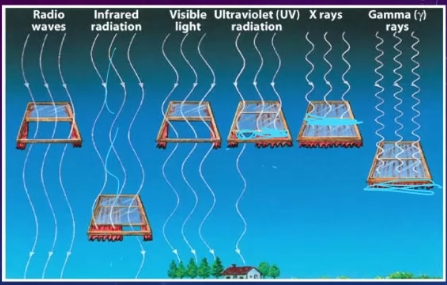Earth 🜨
- ~13,000 kilometers in diameter
- The Moon is the nearest astronomical neighbour

- The Sun is about 150 million kilometers away
- Axis of rotation is tilted 23.5˚
- This is why the Sun is visible for less time in the winter and more time in the summer (in the northern hemisphere)
- Composed primarily of heavy elements
Layers
- Separated into layers of material based on different densities
Crust
- ~0.3% of the Earth's mass
- Various types of rock
- Oceanic crust
- Covers 55% of Earth's surface
- Mostly submerged under oceans
- About 6 km thick
- Composed of volcanic rocks (basalt)
- Continental crust
- Covers 45% of the Earth's surface
- 20-70 km thick
- Predominately composed of granite
Mantle
- Largest part of the solid Earth
- Stretches from base of the crust --> 2900 km deep
- ~84% of Earth's volume
- Made of rock
Core
- 5000 K
- 1.4 million atmospheres
- Diameter of 7000 km
- Larger than the entire planet Mercury
- Outer core is liquid
- Inner core is probably solid
Magnetic Field and Magnetosphere
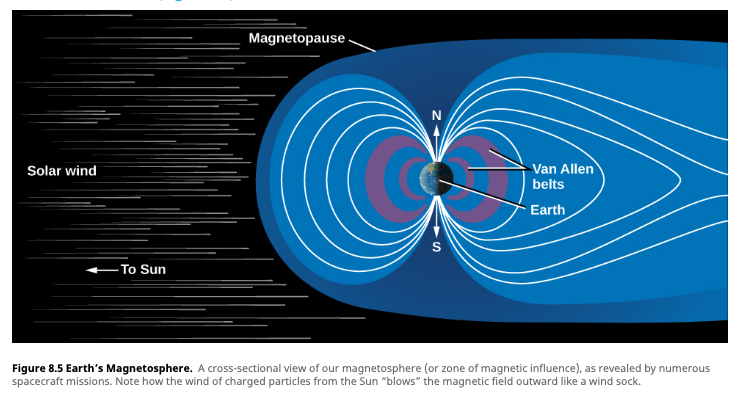
- Magnetic field generated by moving material in the liquid metallic core
- Extends into surrounding space
- Magnetosphere
- The zone within which Earth's magnetic field dominates over the weak interplanetary magnetic field that extends outward from the Sun
- Extends ~60,000 km in the direction of the Sun
- Can reach as far as the orbit of the Moon on the side opposite the Sun
Atmosphere

Atmospheric Layers
Greenhouse Effect
- Trapping of infrared rays
- Visible light comes through, converted to heat, and then cannot escape
Coordinate System
- Axis of rotation defines poles
- Equator is halfway between both poles
- East/west defined by Earth's rotation
- East --> direction toward which Earth rotates
- West --> opposite of East
Calculating Earth's Size in Ancient times
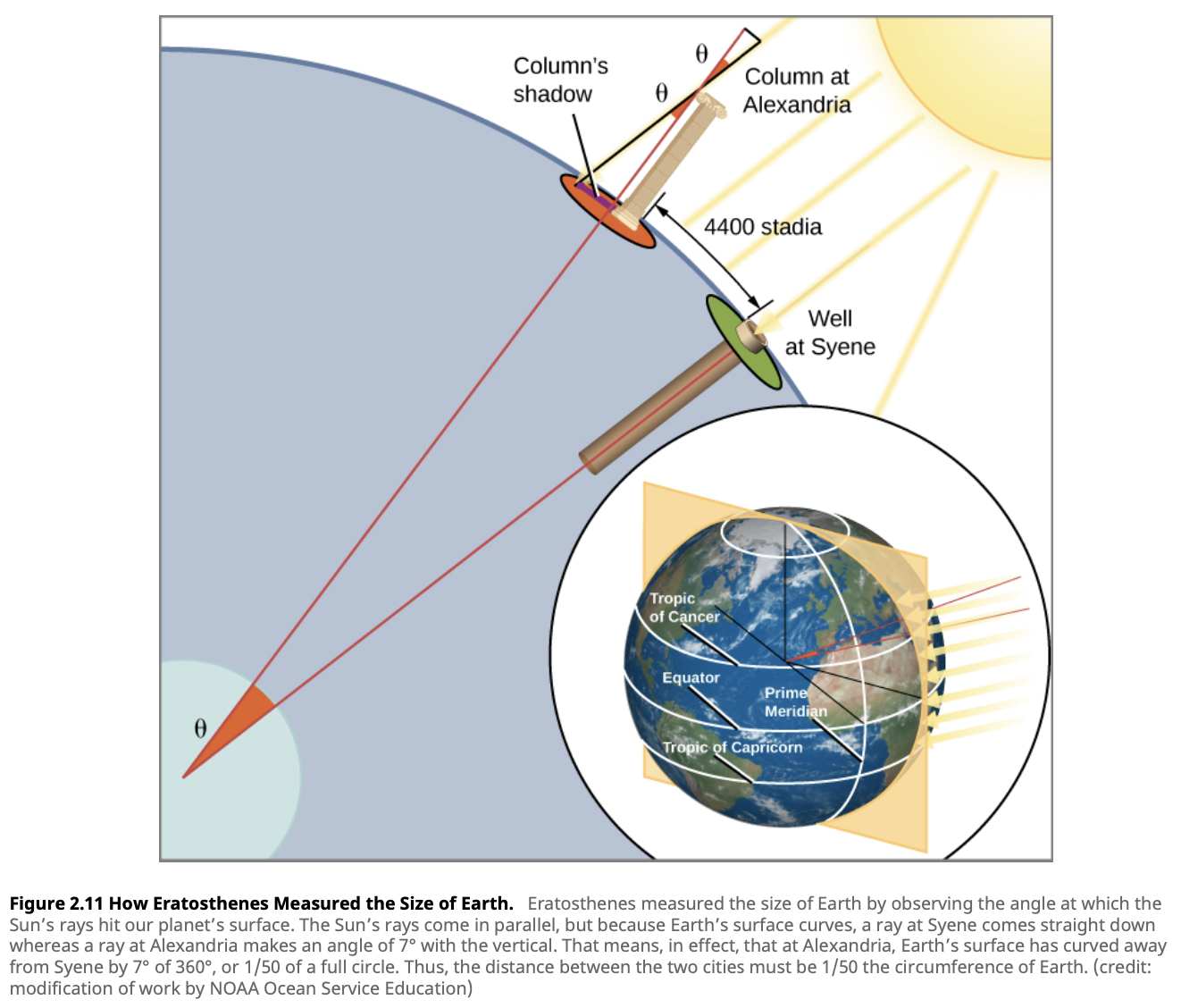
- In Syene, the Sun was straight overhead (no shadows created) but in Alexandria had shadows with 7˚
- This means at Alexandria, Earth's surfaced has curved by 7˚ (1/50 of a full circle)
- The distance between the two cities must then be 1/50 the Earth's circumference, so we can measure that
Orbit
- Distance from the Sun only varies by ~3%
Seasons
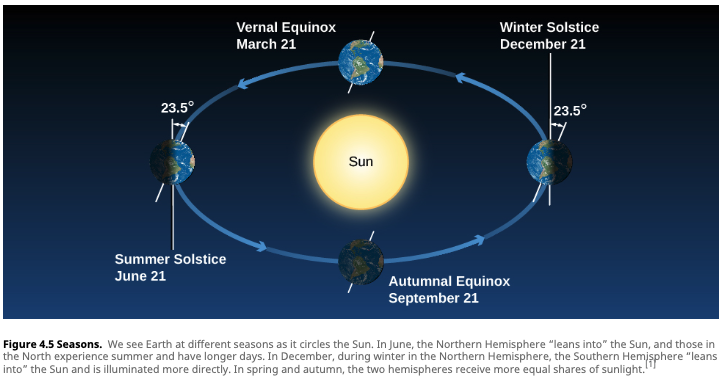
- Caused by the tilt of Earth's axis (23.5˚)
- Depending where the Earth is in its orbit, one of the hemispheres will be more directly illuminated
- Sunlight becomes more/less effective at heating the Earth
- Tilting towards the Sun provides more direct sunlight
- Longer days gives the Sun more time to heat up the Earth
- The Sun will actually spend more/less time above the horizon
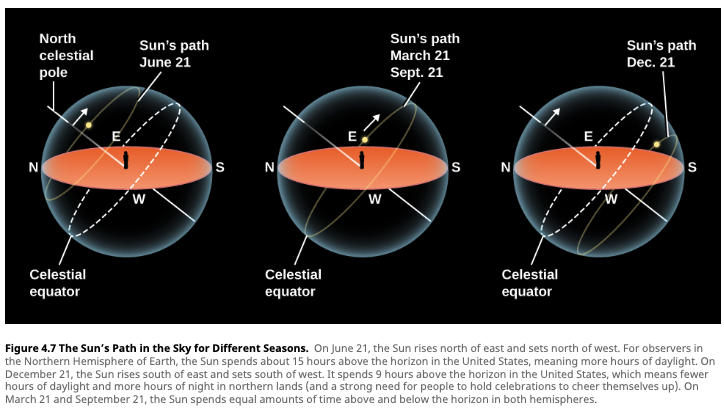
Time

- Solar days are defined in terms of the Earth's rotation with respect to the Sun
- How we tell time
- ~4 minutes longer than a sidereal day ($\frac{1}{365}$ of a day)
- Stars rise 4 minutes earlier every day
- Sidereal days are defined in terms of the Earth's rotation with respect to the stars
- Stars rise at the same sidereal time every day
- Better for observing the stars
- Apparent solar time
- Time determined by the actual position of the Sun
- Time shown on sundials
- Not very convenient for us
- First half of the day, the Sun has not reached the meridian
- Before the Sun reaches the local meridian
- ante meridiem or a.m.
- Second half of the day, after noon
- post meridiem or p.m.
- After the Sun reaches the local meridian
- Mean solar time
- Average value of the solar day over the year
- Exactly 24 hours in a day
- Progresses at a uniform rate
- Standard time
- 24 standardized global time zones
- Each zone keep the same standard time with the local mean solar time running through the middle of each zone
- Travelers change their watches only when time change is >= one hour
Tidal Force

- Not a real force like gravity
- The Moon pulls on the Earth, making tidal bulges in the oceans
- Water on the side facing the Moon flows toward it
- Water on the side away from the Moon has weak influence so tides are high
- Bulges out on the side facing the Moon as well as the side facing away from it
- This causes two high/low tides per day
- Once when away from the Moon, and once when facing it
Space Astronomy








